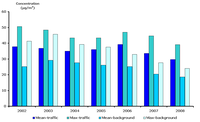
The graph above shows the emissions of ozone precursors (methane CH4; carbon monoxide CO; non-methane volatile organic compounds NMVOCs; and nitrogen oxides NOx) each weighted by a factor prior to aggregation to represent their respective tropospheric ozone formation potential (TOFP). The TOFP factors are: NOx 1.22, NMVOC 1, CO 0.11 and CH4 0.014 (de Leeuw 2002). Results are expressed in NMVOC equivalents (kilotonnes - kt). Data not available for Iceland (emissions of CO, NMVOC, NOx were not reported) and Malta (CO). 'Energy combustion' includes all energy-related emissions minus fugitive.

Emissions intensity is calculated as the amount of pollutant produced (in tonnes) from public electricity and heat production divided by the output of electricity and heat (in toe) from these plants.

Station pairs from capital cities were preferred, but when not available the next largest city for which data was available was chosen

Station pairs from capital cities were preferred, but when not available the next largest city for which data was available was chosen

The ‘pH’ is a measure of acidity – the lower the number the more acidic the ocean becomes. On a geological timescale, ocean pH has been relatively stable. Recently, oceans have been acidifying fast and this is projected to continue at a rate unprecedented for millions of years.

Total GHG emissions in EU-15 and EU-27 in Mt CO2-equivalent

Observed and projected Arctic September sea-ice extent

Note: The maps on the left show the area of the Greenland ice sheet with at least one day of surface melting in summer. The diagram on the left shows the cumulated melt area, which is defined as the annual total sum of every daily ice sheet melt area. For example, if a particular area is melting on 20 days in a given year, it is counted 20 times.

Cumulative specific net mass balance of selected glaciers from European glaciated regions

Comparison of the average annual costs of adaptation in developed countries

Comparison of the average annual costs of adaptation in developing countries

Potential increase in crop production under an adaptation scenario

Projected suitability of the establishment of the tiger mosquito

Present and projected annual water availability per person

Present and projected water limitation of crop primary production in Europe under rain-fed conditions

People expected to be at risk of flooding without adaptation in the medium-long term

Changes of the flowering date for winter planted wheat between 1975 and 2007

Colours show population density

The solid lines are based on observations smoothed to remove the effects of interannual variability (light lines connect data points). Data in most recent years are obtained via satellite based sensors. The envelope of IPCC (2001) projections is shown for comparison; this includes the broken lines as individual projections and the shading as the uncertainty around the projections.

Annual damage and welfare change due to climate change